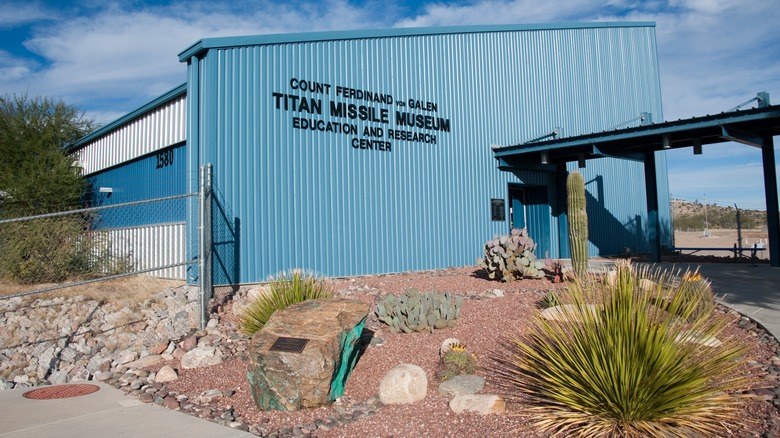How Many ICBM Silos Does The US Air Force Have?
If you grew up during the Cold War, you know all too well the potential horrors of nuclear war. Movies, television shows, and worldwide conflicts made it necessary for American schoolchildren to practice duck and cover drills, hoping to find a way to survive a nearby nuclear detonation. That's a lot of fear for children to have, but one thing that the adults knew was that nuclear war wasn't likely, as modern nukes were and are a weapon better unused than used.
To that end, the U.S. enacted a policy called Mutual Assured Destruction, or MAD. Essentially, it revolved around the Nuclear Triad, a practice of employing Ohio-class nuclear submarines, strategic bombers like the B-21 Raider, and Intercontinental Ballistic Missiles (ICBMs) in various places around the U.S. and in allied territories. MAD ensured that had the Soviet Union attack the U.S. with nuclear arms, they'd receive the same in kind, and since nobody wanted to actually end the world, thousands of nuclear weapons sat unused.
These days, nukes aren't spoken about with the same level of fear, though Russian President Vladimir Putin keeps reminding the world that he has them. For the U.S., many ICBM silos were closed and dismantled, while other aspects of the Nuclear Triad were toned down via the START treaty and others. This leaves the public wondering — how many ICBMs do the U.S. Air Force currently have and operate? The number is surprising, as the U.S. has 450 ICBM silos in operation 24/7.
What kind of ICBMs are maintained by the U.S. Air Force?
The U.S. Air Force is responsible for maintaining the massive stockpile of ICBMs spread around the country. There are up to 400 LGM-30 Minuteman III ICBMs maintained regularly, and they make up the bulk of the land-based nuclear force that's been operating nonstop since 1959. These are kept by several U.S. Air Force units, though there are actually more missiles than there are silos from which to launch them, as the U.S. maintains 450 ICBM silos.
The three-stage Minuteman III ICBM is a massive rocket with a 6,000+ mile range. Once launched, they reach speeds of 15,000 mph, which is equal to Mach 23, and they reach a maximum ceiling of 700 miles. This makes it possible for the missiles to fly outside of air defense range before releasing their payload of nuclear warheads. The current Minuteman III missiles were developed and deployed in 1970 and have remained in service ever since.
A modernization plan will begin in 2029 to replace the nearly 60-year-old missiles while simultaneously upgrading the silos that house them. The new missiles will be developed by Northrop Grumman and are called Sentinel. The current stock of missiles is maintained by several sites, including Warren Air Force Base in Wyoming, Malmstrom Air Force Base in Montana, and Minot Air Force Base in North Dakota. All told, more than 10,000 personnel manage the U.S. stock of ICBMs.
[Featured image by Acdx via Wikimedia Commons | Cropped and scaled | Public Domain]
You can visit a U.S. ICBM silo
For the vast majority of people, working with nuclear weapons isn't something that's an option. After all, the nuclear stockpile is one of the most guarded and secretive things in the world, which is a good thing. That's certainly true of all the active ICBM silos in the world, and while you can't walk up and visit one, there's a silo you can visit. If you head to Sahuarita, Arizona, just south of Tucson, you'll find the Titan Missile Museum, which offers tours of the silo.
The U.S. stopped using the LGM-25C Titan II ICBM in 1987 due to modernization efforts. The missiles were exceptionally large, and all but one silo, Site 571-7, was demolished. The only remaining silo was transformed into the Titan Missile Museum, which contains an actual Titan II missile.
Of course, the missile that remains at the museum was never fueled or fitted with a warhead, as it was a training missile. Despite this, it looks like a nuclear ICBM because that's precisely what it is. The museum opened on May 21, 1986, and visitors can engage in a mock launch in the silo or head to the surface and peek inside. The silo's doors have been modified with glass for this purpose.


